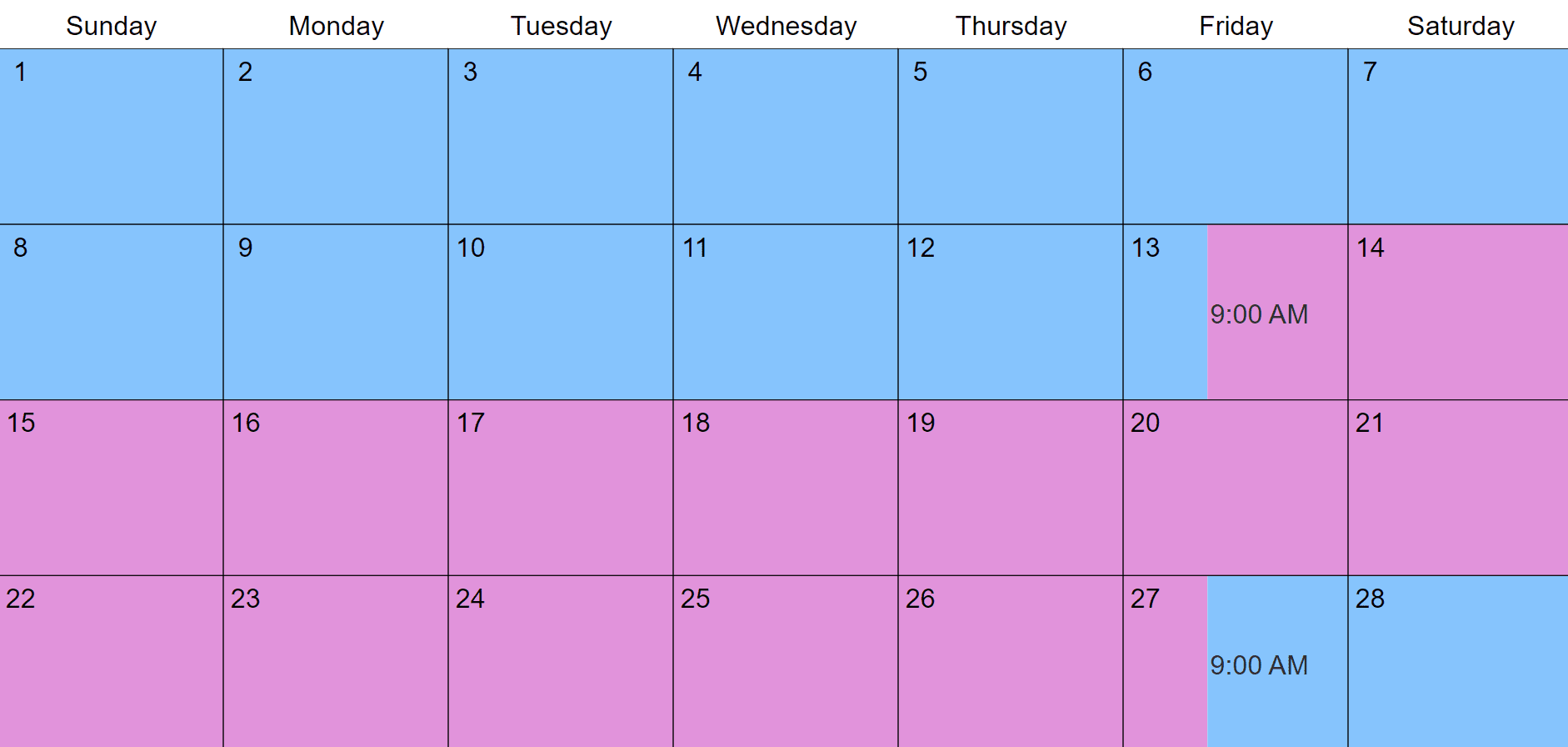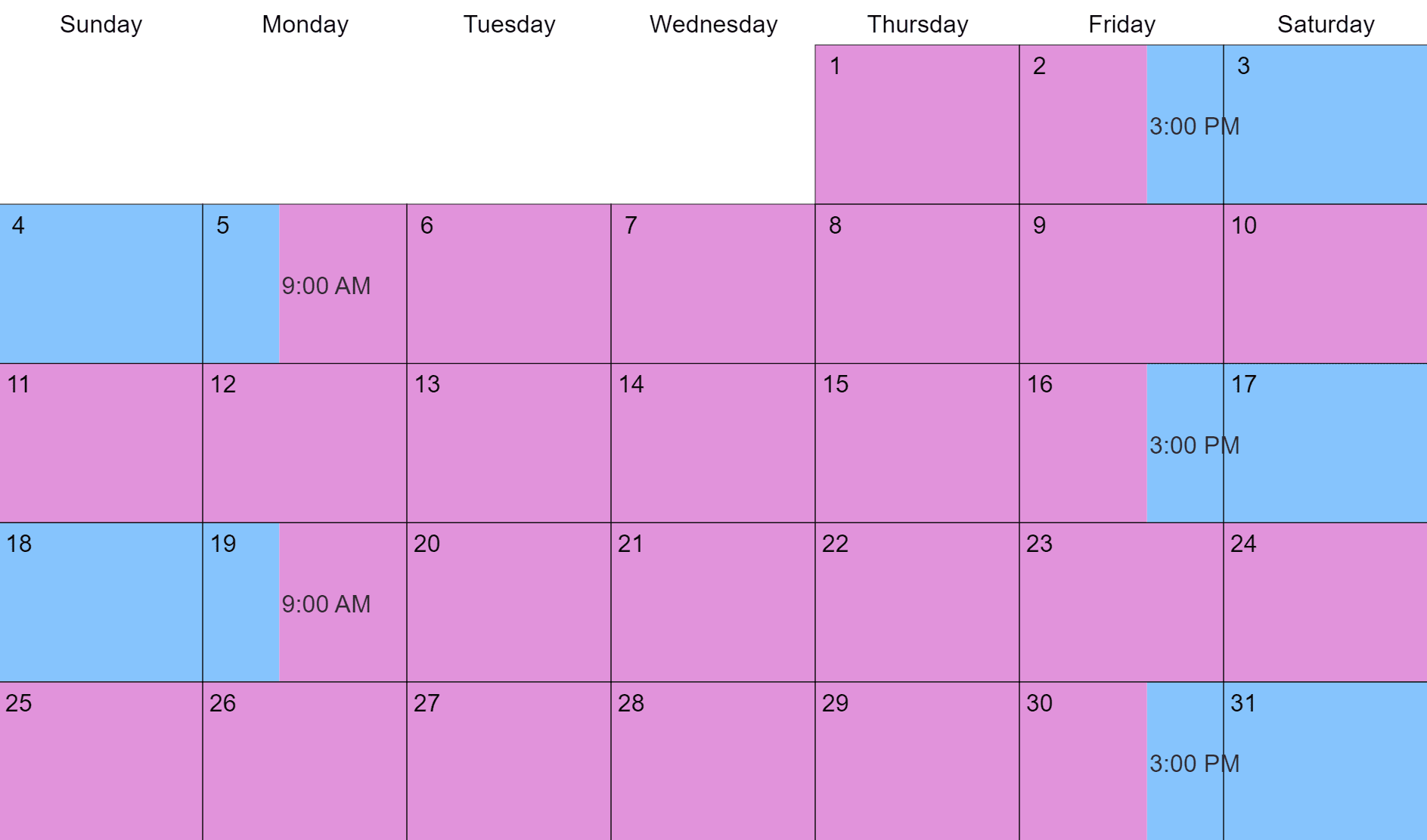Parenting Time Schedules in Alberta
A parenting time schedule details when a child will be with each parent.
On this page
Either parents agree on a schedule and include it in their parenting plan or a judge decides the schedule after a trial. In the latter case, parents receive a court order that includes the schedule. In the former, parents may ask the court for an order that includes their agreement so it's enforceable.
A schedule in a court order must be described in writing. You can add a visual calendar in your parenting plan for easier comprehension.
If you need help agreeing on a schedule, you can try an alternative dispute resolution method.
Your schedule will likely need to change as your child gets older. You can write changes into your schedule now or make them later. The court has to approve any major changes to a court-ordered schedule.
Some parents opt to not use a schedule, and they agree when to exchange the child as they go. The court may order this "reasonable" parenting time arrangement for parents who get along well.
Someone who is not the child's guardian can have contact (visits) with the child. In rare cases, contact is ordered by a court. You may choose to incorporate contact into your schedule as 3rd party time.
Types of parenting time arrangements
Most commonly, parents in Alberta have shared parenting time. This means the child spends at least 40 percent of the year with each parent.
When a parent has more than 60 percent of annual parenting time, they are said to have primary care. The child generally visits the other parent, called the access parent, regularly. If the child can't be alone with the access parent safely, the court may require supervised visitation, visitation in a public place, or remote visitation (via phone or video call).
In extraordinary circumstances, a judge may rule that a parent should not have any contact with their child at all.
Shared parenting time schedules
The following schedules are popular with Albertan parents who share parenting time. Choosing a schedule can be tricky because you have so many options. Consider basing your schedule on your child's age.
Every extended weekend (60/40 schedule)
The every extended weekend schedule is a good choice for kids who are just starting school. The child goes to the other parent's household after school on Fridays and spends the entire weekend with them before returning to school on Monday.

You can customize this to fit your situation with Custody X Change.
2-2-5-5 (50/50 schedule)
Frequent exchanges are ideal for kids under 10. Thus, the 2-2-5-5 schedule is popular for this age group. The child spends two days with one parent, then two days with the other parent, then five days with each parent to complete the rotation.

You can customize this to fit your situation with Custody X Change.
Alternating weeks (50/50 schedule)
For children 10 and over, the alternating weeks schedule is a popular option. The child spends one week with one parent, then switches to the other parent for one week.

You can customize this to fit your situation with Custody X Change.
Every two weeks (50/50 schedule)
Teenagers with busy schedules may prefer to stay in one spot longer to avoid disrupting their personal schedules. With the every two weeks schedule, the child switches homes every two weeks.

You can customize this to fit your situation with Custody X Change.
Primary care schedules
The following are popular schedules when one parent has less than 40 percent of the parenting time. These often come into play when parents don't live near each other or the child is not used to spending time with the access parent.
Alternating weekends (80/20 schedule)
The alternating weekends schedule is common for parents who live some distance from one another.
Every other weekend, the child spends Friday evening to Monday morning with the access parent. You can pick different days if they work better for your family: Thursday to Sunday, Friday to Sunday, etc.

You can customize this to fit your situation with Custody X Change.
1st, 3rd and 5th weekends (80/20 schedule)
Another option for distanced arrangements is the 1st, 3rd and 5th weekends schedule. This schedule gives the access parent the first, third and fifth weekend of the month.

You can customize this to fit your situation with Custody X Change.
Daytime-only schedule (90/10 schedule)
A daytime-only schedule is common for infants. Infants need frequent contact with each parent, and you may have to work around breastfeeding.
This is also a good schedule if you're trying to ease your child into spending time with the access parent.

You can customize this to fit your situation with Custody X Change.
Holidays and vacation schedules
You should also create a holiday schedule and a vacation schedule.
There are many ways to divide holidays, including:
- Alternating holidays by even- and odd-numbered years
- Alternating holidays within the same year (e.g., One parent has Christmas Eve, and the other has Christmas Day.)
- Designating holidays based on what is being celebrated (e.g., Mom gets Mother's Day, while Dad gets Father's Day.)
- Following your regular schedule and allowing the child to spend the holiday with the parent they're already with
For vacation time, you can set specific dates or set allowances. With vacation allowances, each parent gets a certain number of vacation days each year with the child.

You can customize this to fit your situation with Custody X Change.
The easiest way to make a schedule
If you're like most parents, creating a parenting time schedule will feel daunting. How do you address holidays, school breaks and birthdays while ensuring the schedule will work in the years to come?
The Custody X Change app makes it easy. First, click and drag in your colour-coded calendar.

You can customize this to fit your situation with Custody X Change.
Then watch as your choices automatically apply to future years and a full description appears in your Custody X Change parenting plan.

You can customize this to fit your situation with Custody X Change.
The combination of a visual and written schedule means your family will have no problem knowing who has the child when. Take advantage of Custody X Change to make your schedule as clear and thorough as can be.
